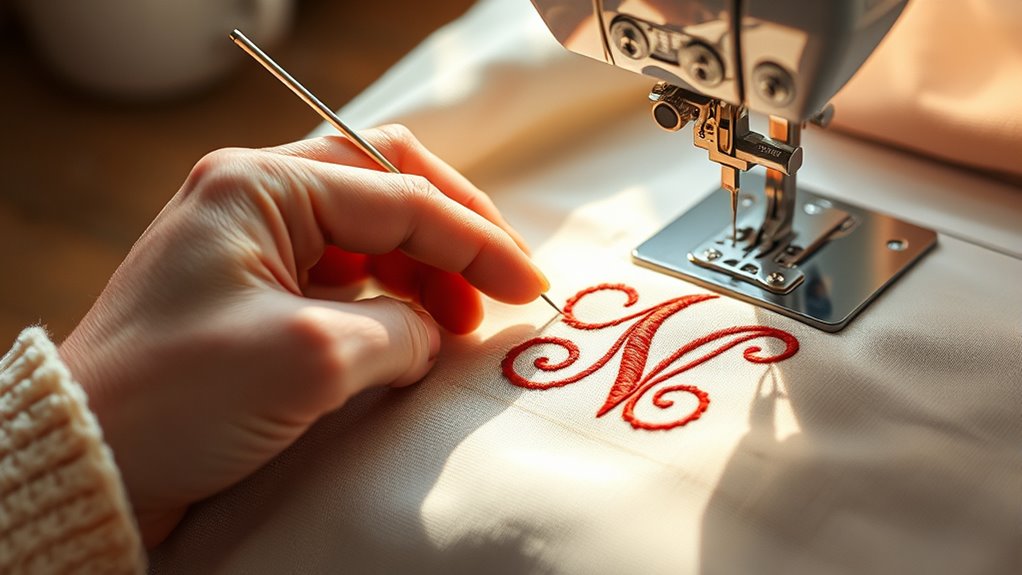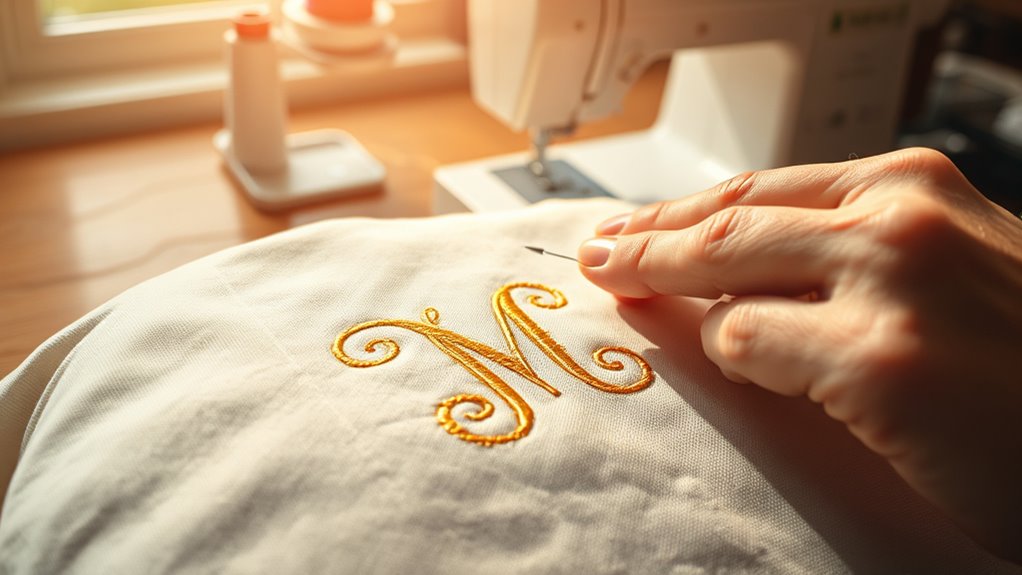To embroider letters by hand or machine, start with selecting the right fabric and design, then choose suitable threads like polyester for durability or cotton for softer looks. For hand embroidery, use small, even stitches with a hoop to keep tension, while machine embroidery benefits from tight hooping and adjusting stitch settings. Practice on scrap fabric first to perfect your technique. Explore the techniques and materials further to create personalized, professional-looking monograms.
Key Takeaways
- Choose the appropriate embroidery technique, like satin or backstitch for clean letters, depending on skill level and desired effect.
- Select durable threads such as polyester or cotton, matching or contrasting colors to enhance visibility and style.
- Carefully mark your design on fabric with water-soluble pen or chalk, and hoop fabric tightly for even stitching.
- Maintain consistent stitches and practice on scrap fabric to achieve neat, professional-looking monograms.
- Experiment with different textures, colors, and techniques to create personalized, distinctive embroidered monograms.

Have you ever wondered how to add a personal touch to your belongings? Monogramming is a fantastic way to do just that, whether you want to customize a towel, tote, or garment. To start, understanding embroidery techniques and choosing the right thread are essential. When you’re working by hand or machine, selecting the appropriate embroidery techniques will influence the look and durability of your monogram. For beginners, simple satin stitches or backstitches work well for clean, bold letters, while more advanced techniques like fill stitches or decorative stitches can add texture and flair.
Thread selection plays a vital role in the overall outcome of your monogram. You want to choose threads that complement your fabric and stand out clearly. Typically, polyester embroidery threads are durable and colorfast, making them ideal for items that will be washed frequently. If you’re aiming for a vintage or softer aesthetic, cotton threads can give a more matte and traditional look. When picking your thread, consider the thickness—most embroidery threads are available in various weights, with heavier threads creating more prominent stitches and finer threads offering delicate detail. Also, match the thread color carefully to your fabric background; contrasting colors help your monogram pop, but tone-on-tone can provide a subtle, sophisticated effect.
Before you begin stitching, prepare your fabric by marking the placement of your monogram with a water-soluble pen or chalk. This ensures your letters are straight and centered. If you’re using a machine, hoop your fabric tightly to prevent puckering and maintain even tension, which is critical for consistent embroidery. For hand embroidery, secure your fabric in an embroidery hoop, keeping the tension even as you stitch. Whichever method you choose, practice your design on a scrap piece first. This trial run helps you get comfortable with the embroidery techniques and thread handling, reducing mistakes on your actual project. Additionally, understanding embroidery techniques can help you achieve different textures and effects, making your monogram more personalized and unique.
When stitching, keep your stitches even and consistent. Take your time and don’t rush; neat, precise stitches make your monogram look professional. If you’re using a machine, experiment with different stitch settings to find the best for your design. For hand embroidery, use small, even stitches to ensure clarity in your letters. Remember, your choice of embroidery techniques and thread selection can profoundly impact the final look, so take your time to pick what suits your style and project. With patience and practice, you’ll be creating beautifully monogrammed items that reflect your personality and craftsmanship.
Frequently Asked Questions
What Fabric Types Are Best for Monogramming?
You should choose fabrics like cotton, linen, or canvas for monogramming because they’re sturdy and easy to work with. These fabrics handle embroidery tools well and maintain their shape, making it easier to create clean, precise letters. Always consider fabric care to guarantee your monogram stays vibrant and intact over time. Smooth, tightly woven fabrics are ideal, providing a solid base for beautiful embroidery results.
How Do I Choose the Right Thread Color?
Choosing the right thread color can transform your monogram from ordinary to eye-catching, like a burst of fireworks! Consider thread contrast to make your initials pop against the fabric, ensuring clarity and style. Think about color symbolism too—red for passion, blue for calm. Match your thread with your fabric or create a striking contrast for emphasis. Trust your instincts, and don’t be afraid to experiment for stunning results!
What Are Common Mistakes in Hand Embroidery?
You might struggle with inconsistent stitch tension, which can make your embroidery look uneven. Make certain you select the right embroidery hoop to keep the fabric taut and prevent puckering. Avoid pulling the thread too tightly or leaving it too loose, as both affect stitch quality. Practice maintaining steady, even stitches and adjust your hoop as needed to keep tension uniform. These steps help create polished, professional-looking embroidery.
How Do I Remove Monograms From Fabric?
To remove monograms from fabric, start by carefully soaking the area in a fabric dye removal solution or a color remover designed for your fabric type. Gently rub or blot to lift the embroidery, then rinse thoroughly with cold water. If the monogram persists, repeat the process. Always test the dye removal method on a small, inconspicuous area first to prevent damaging your fabric.
Can Monogramming Be Done on Leather or Plastic?
You can definitely monogram on leather or plastic, proving that “where there’s a will, there’s a way.” For leather customization, use specialized tools like leather-safe inks, dyes, or embossing techniques. Plastic monogramming works best with heat-set or adhesive vinyl options. Just verify your materials are compatible with these methods, and you’re good to go. With the right approach, you can personalize almost any surface!
Conclusion
Now that you know how to embroider letters by hand or machine, you’ll enjoy adding a personal touch to your projects. Imagine customizing a tote bag with your initials, turning it into a one-of-a-kind accessory. Just like Sarah did for her wedding favors, your monogramming skills can create meaningful, memorable gifts or decor. Keep practicing, and soon you’ll confidently craft beautiful, professional-looking monograms that truly reflect your style!









